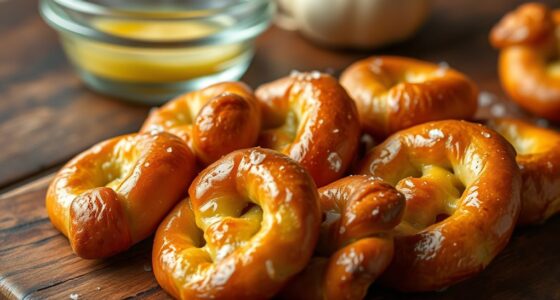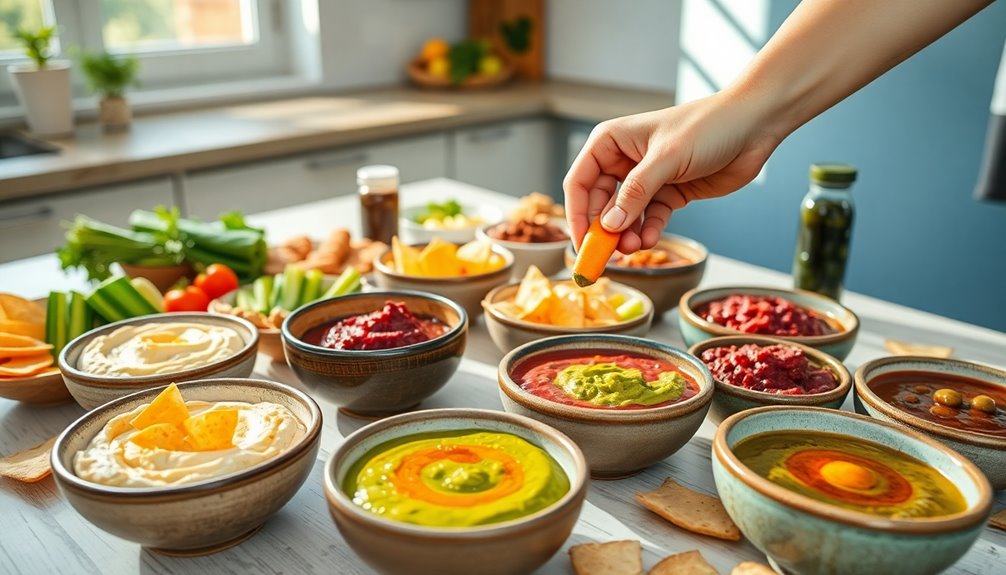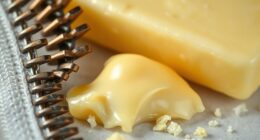To improve seasoning retention in butter-roasted chickpea crunch, focus on controlling moisture levels, using proper application techniques like pre-coatings or binding agents, and choosing butter with a suitable melting point. Roasting at moderate temperatures helps prevent seasoning washout while preserving flavor. Maximizing fat content enhances flavor stability, and airtight packaging prolongs freshness. Continue exploring these factors to discover effective methods for consistently delicious and well-seasoned chickpea snacks.
Key Takeaways
- Proper moisture control and pre-treatment enhance seasoning adhesion and reduce wash-off during roasting.
- Selecting butter with suitable melting point preserves flavor compounds and minimizes moisture loss.
- Optimized roasting temperature and time prevent seasoning degradation and maintain flavor integrity.
- Using stable, oil-soluble seasonings and airtight storage techniques extend seasoning retention over shelf life.
- Layering seasonings and employing effective packaging methods improve long-term flavor preservation in butter-roasted chickpeas.
Factors Influencing Seasoning Adhesion During Roasting
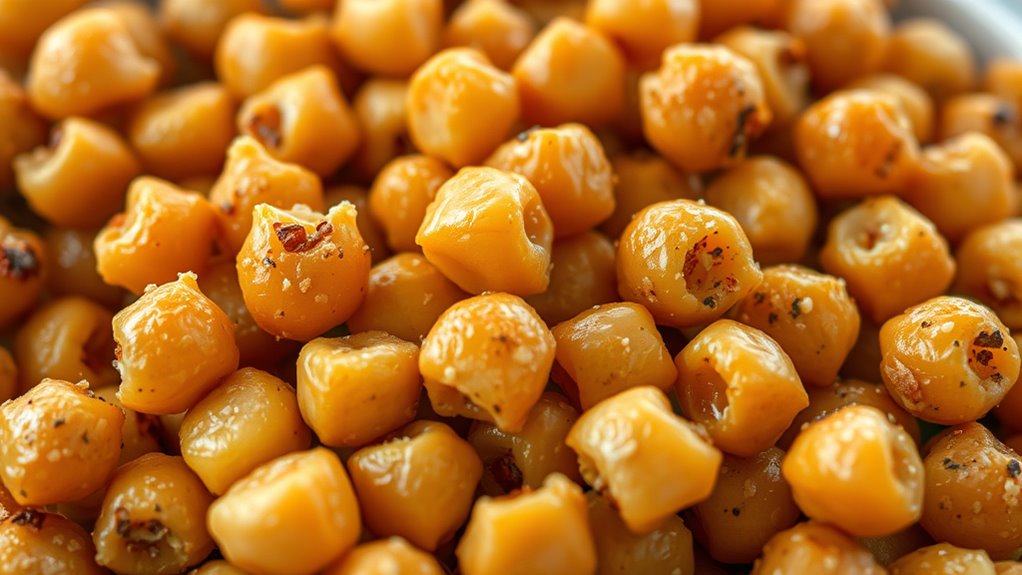
When roasting chickpeas, the way seasonings stick depends largely on the moisture content of the beans and the application method. One key factor is seasoning particle size; finer particles tend to adhere better because they create a more uniform coating, while larger particles may fall off more easily. Moisture content effects are equally important—slightly damp beans help seasonings adhere by providing a sticky surface, but too much moisture can hinder proper roasting and seasoning adhesion. If chickpeas are too dry, seasonings may not stick well, leading to uneven flavor distribution. Conversely, overly moist chickpeas can cause seasonings to clump or wash away during roasting. Balancing moisture levels and choosing appropriately sized seasoning particles are essential for maximum adhesion during the roasting process. Proper seasoning adhesion can also be influenced by the surface characteristics of the beans, which can be optimized through specific pre-treatment methods.
Impact of Butter Composition on Flavor Preservation
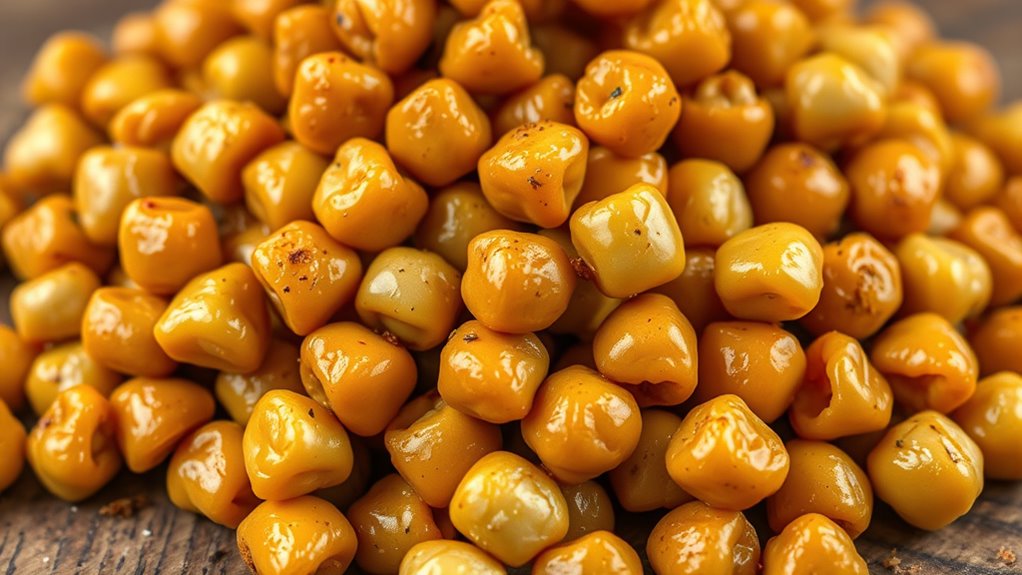
The type of butter you use can considerably influence how well flavors are preserved during roasting. Variations in melting points affect how evenly butter coats the chickpeas and retains aroma, while different fats impact oil-soluble flavors. Understanding these factors helps you choose the best butter for maximum flavor retention in your crunch. Additionally, selecting high-quality butter can enhance flavor and ensure a richer, more satisfying snack.
Fat Type Effects
Butter’s composition substantially influences how well its flavor components are preserved during roasting. When choosing butter types, consider how their fat profiles impact aroma retention; for example, higher butterfat can enhance the nutty aroma that develops during roasting. The fat type also affects texture enhancement, making the chickpeas crispier and more satisfying. Clarified butter or ghee, with fewer water content, tends to maintain flavors better, avoiding dilution of aromatic compounds. Conversely, whole butter contains milk solids that may alter flavor stability. Your choice of butter influences not only taste but also the overall crunch. Selecting a butter with a balanced fat composition ensures that the nutty aroma remains prominent and the texture benefits are maximized, resulting in a more flavorful, crispy chickpea snack. Additionally, understanding how fat composition impacts flavor retention can help optimize your roasting process for better results.
Melting Point Variations
Variations in melting points among different types of butter markedly influence flavor preservation during roasting. When butter melts at lower temperatures, moisture migration increases, which can accelerate spoilage mechanisms like enzymatic activity and microbial growth. Conversely, higher melting point butters remain solid longer, limiting moisture loss and reducing spoilage risks. This stability helps maintain the butter’s flavor compounds, preventing them from volatilizing or degrading prematurely. Melting point differences also affect how evenly heat is transferred, impacting flavor retention in the chickpeas. Understanding these variations allows you to select butter with the appropriate melting profile, ensuring maximum flavor preservation and minimizing spoilage during roasting. Additionally, storage conditions can influence the melting behavior and overall quality of butter, further affecting flavor retention. By controlling melting behavior, you can optimize seasoning retention without compromising product quality.
Oil-Soluble Flavor Retention
Since butter contains a complex mix of fats and flavor compounds, its composition directly impacts how well those flavors are retained during roasting, especially in the oil-soluble form. The fats help solubilize herb infusions and spices, enhancing flavor retention. Higher levels of unsaturated fats improve spice solubility, allowing more flavor compounds to dissolve and stay embedded during cooking. Butter’s specific fatty acid profile influences how effectively herb oils and spice extracts are preserved, preventing flavor loss. Additionally, certain butter compositions can create a more stable environment for oil-soluble flavors, reducing volatility and evaporation. Understanding fatty acid profiles can help optimize flavor retention and ensure your roasted chickpeas maintain their aromatic, savory qualities throughout roasting. Adjusting the butter’s fat content and incorporating specific herbs can further enhance flavor stability, ensuring a flavorful final product.
Techniques for Enhancing Seasoning Retention in Butter Roasting

To make certain your seasoning stays put during butter roasting, it’s essential to implement specific techniques that promote better adhesion. You can improve seasoning retention by optimizing seasoning solubility and controlling flavor diffusion. First, apply a light coating of oil or moisture to enhance adhesion. Second, use dry rubs or powders that bond better with chickpeas. Third, pre-coat chickpeas with a binding agent like egg wash or cornstarch. Fourth, roast at controlled temperatures to prevent seasoning from washing away. Fifth, consider layering seasonings—initially applying a base coat, then adding additional flavors midway. Additionally, understanding seasoning retention principles can help you develop more flavorful dishes. Here’s a helpful guide:
| Technique | Purpose | Result |
|---|---|---|
| Use binding agents | Improve seasoning adherence | Reduced seasoning loss |
| Control roasting temperature | Prevent seasoning washout | Better flavor retention |
| Layer seasonings | Enhance flavor diffusion | More intense, lasting flavor |
Comparative Analysis of Different Seasoning Formulations

Have you ever wondered how different seasoning formulations impact the flavor and texture of butter-roasted chickpeas? The choice of seasoning formulation directly influences flavor stability during roasting, affecting how well the flavors remain intact. Some formulations include salt-based blends, spice mixes, or umami-rich ingredients, each offering unique effects on taste. You’ll notice that certain formulations better preserve flavor stability, preventing loss or degradation during roasting. Others may enhance aroma or texture, but compromise flavor retention. By comparing these formulations, you can identify which ingredients and ratios optimize flavor stability and provide consistent, appealing taste. This analysis helps determine the most effective seasoning combinations for achieving a flavorful, crunchy chickpea snack that maintains its seasoning integrity through the roasting process.
Effects of Roasting Temperature and Duration on Flavor Stability

Roasting temperature and duration directly influence the flavor stability of your chickpeas. Higher heat can intensify flavors but may also cause undesirable bitterness if overdone, while shorter roasting preserves freshness. Finding the ideal balance ensures your chickpeas stay flavorful and crunchy without losing quality. Additionally, experimenting with different roasting times and temperatures can help identify the optimal conditions for flavor retention, similar to how finding hackathons involves exploring various platforms and communities to discover the best opportunities.
Temperature Impact on Flavor
The temperature at which you roast chickpeas directly influences their flavor stability, with higher temperatures often accelerating the development of complex aromas but risking bitterness or burnt notes if not carefully monitored. Roasting too hot can compromise shelf life by creating uneven flavor profiles and reducing freshness over time. Proper control ensures flavor retention during storage, preventing spoilage or off-flavors. Keep in mind that moderate temperatures help preserve natural nutty notes and prevent excessive Maillard reactions. Additionally, consistent roasting practices contribute to maintaining flavor quality throughout storage.
Roast Duration Effects
Extending the roasting time at a given temperature intensifies flavor development but can also compromise stability if not carefully managed. Longer roasting can lead to nutrient degradation, reducing the chickpeas’ nutritional value. Additionally, extended durations often cause noticeable texture changes, such as increased crispness or potential charring, which may affect consumer preference. Over-roasting risks creating a bitter taste and uneven moisture loss, impacting the overall crunch. To preserve flavor stability and nutrients, you need to balance roast time carefully. Monitoring the duration ensures the chickpeas reach ideal texture without sacrificing quality. Proper filtration of the roasting environment can help maintain consistency and prevent contamination, further supporting flavor stability. Ultimately, controlling roast duration is essential to maintain a desirable flavor profile while minimizing nutrient loss and undesirable texture alterations.
Optimal Baking Conditions
Achieving ideal baking conditions requires carefully balancing temperature and duration to preserve flavor stability. Too high a temperature or prolonged roasting can cause seasoning diffusion, leading to flavor loss and uneven seasoning distribution. Conversely, lower temperatures or shorter times help maintain seasoning integrity and enhance flavor retention. Optimal baking also influences texture modification, where moderate heat ensures a crispy exterior without over-drying the chickpeas. Adjusting roasting parameters helps prevent flavor degradation caused by excessive heat, ensuring the butter and seasoning remain stable. Additionally, understanding the contrast ratio of the oven or baking environment can assist in maintaining consistent heat distribution, which is vital for uniform roasting. By fine-tuning temperature and duration, you can maximize seasoning retention while achieving the desired crunch. This balance guarantees a flavorful, well-textured chickpea crunch with preserved seasoning, delivering consistent quality in every batch.
Recommendations for Optimizing Flavor Retention in Chickpea Snacks
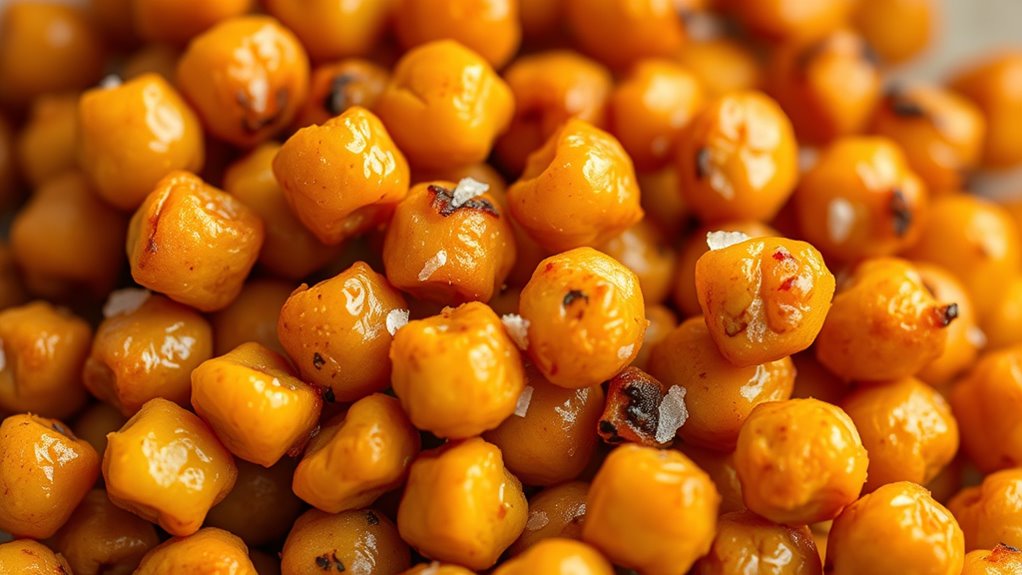
To maximize flavor retention in chickpea snacks like butter-roasted chickpeas, focus on proper seasoning techniques and storage methods. Using precise seasoning application helps lock in flavors and prevents loss during processing. Incorporate nutrient preservation strategies by choosing seasonings that are stable under heat and resistant to oxidation. Packaging strategies also play a crucial role; airtight containers or vacuum sealing reduce exposure to oxygen and moisture, which can degrade flavor and nutrients over time. Keep packaging away from light and heat, as these factors accelerate flavor loss. Proper storage ensures the seasoning stays vibrant and the nutrients remain intact. By combining effective seasoning methods with suitable packaging, you’ll preserve the authentic flavor and nutritional quality of your chickpea snacks longer.
Frequently Asked Questions
How Does Chickpea Size Affect Seasoning Absorption During Roasting?
You might notice that chickpea size influences seasoning absorption during roasting. Smaller chickpeas tend to absorb seasonings more effectively because their increased surface area allows for better penetration. In contrast, larger chickpeas may have less seasoning absorption, as their interior remains less exposed. By selecting the right chickpea size, you can optimize flavor retention, ensuring your roasted chickpeas are flavorful and well-seasoned throughout the entire snack.
What Role Does Moisture Content Play in Seasoning Retention?
Moisture content influences seasoning retention through moisture variability, which affects how seasonings diffuse into chickpeas. When moisture levels are high, seasonings can penetrate more effectively, leading to better flavor absorption. Conversely, low moisture limits diffusion, causing seasonings to stay on the surface and potentially wash away during roasting. By controlling moisture, you optimize seasoning retention, ensuring consistent flavor and improved product quality.
Are There Natural Additives That Improve Seasoning Adhesion?
You might think natural additives can’t boost seasoning adhesion, but research suggests otherwise. Natural binders like honey or molasses can improve spice encapsulation, helping seasonings stick better. These additives create a thin film that traps spices, reducing loss during roasting or handling. Incorporating such binders not only enhances flavor retention but also keeps your chickpeas flavorful and crispy longer, making your snacks more appealing and satisfying.
Can Pre-Soaking Influence Flavor Retention in Butter-Roasted Chickpeas?
Pre-soaking can considerably influence flavor retention by enhancing flavor lock and coating adhesion. When you soak chickpeas beforehand, they absorb moisture, which helps seasonings stick better during roasting. This process improves coating adhesion, ensuring flavors stay on the surface rather than falling off. As a result, pre-soaking creates a more flavorful, evenly seasoned chickpea crunch, maximizing taste and texture while reducing seasoning loss during cooking.
How Does Packaging Impact Seasoning Preservation Over Shelf Life?
Imagine opening a bag of chickpeas, only to find the flavor faded. Packaging integrity plays a vital role in this. If the seal breaks or the material isn’t airtight, flavor migration can occur, causing seasoning loss over shelf life. Proper packaging keeps your seasoning fresh and vibrant, preventing air and moisture from compromising flavor. So, choosing the right packaging directly impacts how long your chickpeas stay flavorful and delicious.
Conclusion
To keep that irresistible crunch and bold flavor, focus on balancing your butter’s richness with precise roasting. Imagine the chickpeas basking in golden heat, their seasoning clinging like a second skin. By adjusting temperature and applying smart techniques, you’ll lock in every savory note. With mindful seasoning and careful roasting, your snack will burst with flavor, crisp and delicious—an irresistible symphony of taste that delights with every bite.



